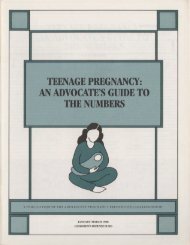child care - Digital Library Collections
child care - Digital Library Collections
child care - Digital Library Collections
You also want an ePaper? Increase the reach of your titles
YUMPU automatically turns print PDFs into web optimized ePapers that Google loves.
......._---'T;..;;.;;H....;;E STATE OF AMERICA'S CHILDREN YEARBOOK 1998<br />
and 10 million in 1975 to 20 million in 1996. The<br />
decline in private coverage for <strong>child</strong>ren, however,<br />
has begun to overshadow the Medicaid expansions.<br />
As a result, the number and percentage of uninsured<br />
<strong>child</strong>ren have risen to historic levels.<br />
Changes in Medicaid. In 1973 Medicaid coverage<br />
was largely tied to whether a family received<br />
cash assistance. In most states, <strong>child</strong>ren and pregnant<br />
women were denied Medicaid if their family<br />
income was too high to qualify for Aid to Families<br />
with Dependent Children (AFDC), even when<br />
that income was substantially below the federal<br />
poverty line.<br />
Dramatic changes occurred in the mid-1980s.<br />
The federal government fIrst permitted and then<br />
required states to extend Medicaid to large numbers<br />
of previously uninsured <strong>child</strong>ren and pregnant<br />
women from low-income, working families, and<br />
many states went beyond the minimum federal requirements.<br />
Medicaid eligibility was also expanded<br />
in many states to include numerous <strong>child</strong>ren with<br />
disabilities, including those from moderate-income<br />
families. Currently Medicaid covers one in four<br />
American <strong>child</strong>ren, including a large proportion of<br />
newborns and <strong>child</strong>ren with disabilities.<br />
The benefIts provided under Medicaid also expanded<br />
considerably (at least on paper) with the<br />
1989 enactment of Early and Periodic Screening,<br />
Diagnosis, and Treatment (EPSDT) requirements<br />
that <strong>child</strong>ren covered by Medicaid must receive<br />
any medically necessary health <strong>care</strong>. The 1989 provisions<br />
require states to provide <strong>child</strong>ren with services<br />
that may not be covered for other age groups<br />
under state Medicaid programs.<br />
The move to managed <strong>care</strong>. The country's basic<br />
health <strong>care</strong> delivery system has undergone fundamental<br />
change over the past 25 years. In the 1970s<br />
most Americans received health <strong>care</strong> through feefor-service<br />
insurance. They could seek <strong>care</strong> from<br />
any provider, and insurers reimbursed for services<br />
provided. In recent years increasing numbers of<br />
families have been enrolled in managed <strong>care</strong> plans,<br />
which offer more limited choice of providers and<br />
often reimburse for set fees regardless of the services<br />
provided.<br />
The era ofmanaged <strong>care</strong> has brought new challenges.<br />
Instead ofreceiving <strong>care</strong> from solo or group<br />
physician practices or from nonprofIt community<br />
hospitals, many families must now rely on forprofIt<br />
corporate entities of increasing size. In the<br />
• In 1996, 11.3 million <strong>child</strong>ren through age 18 had no health<br />
insurance-the highest number ever recorded by the Census<br />
Bureau. Seventy percent af all Americans added to the ranks af the<br />
uninsured that year were age 18 or younger.<br />
• Ninety-two percent of uninsured <strong>child</strong>ren have at least one working<br />
parent; 66 percent have a parent who warks full-time and<br />
year-round.<br />
• In 1996 more than 40 percent of Medicaid beneficiaries were<br />
enrolled in managed <strong>care</strong> plans; as recently as 1991, fewer than<br />
10 percent were enrolled.<br />
• By 1996, 78 percent of all 2-year-olds were fully immunized, up<br />
from 55 percent in 1992.<br />
• Infant mortality is at its lowest level ever (7.6 deaths per 1,000 live<br />
births in 1995). Although maternal and <strong>child</strong> health indicators have<br />
impraved among Black <strong>child</strong>ren since 1991, their infant mortality<br />
rate (15.1 per 1,000) remains disturbingly high.<br />
22 CHI L D R EN'S D E FEN S E F V N D














